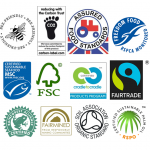The last month I’ve seen so many articles and news items on green/sustainable claims – even the One Show (hardly the cutting edge of journalism) got in on the act last week and did a spot on greenclaims in household cleaners and how misleading and unregulated they are. The comparison was drawn with Fairtrade, which everyone understands and which breeds trust and confidence.
It seems like this is a massive marketing issue, of many voices but no large ‘brand’ that embodies trust and confidence across the board. Labels do exist, both at European and local level, however apart from the EU flower label (which covers a ‘bare minimum’ of sustainability items and is awarded per category), they tackle specific issues, or are only from a specific company. For example the Carbon Trust’s ‘carbon footprint’ (currently part of their decarbonising the brand programme), currently slowly rolling out from a startpoint on Walkers crisps and Boots shampoos, but not yet understood or actionable by consumers. Or the Reckitt Benckiser or Unilever corporately branded sustainability initiatives that go across all owned consumer brands. And this week in the news is Prince Charles’s launch of Start, a major sustainability initiative that he is personally broadcasting in a roadshow from Glasgow to London and involving brands such as M&S (Plan A) under this umbrella. Yet still, the vast majority of ‘greener’, sustainable or low impact claims, are vague, and unqualified by any external measurement, and are contributing to a noise around green that makes it hard for a consumer to know what is greenwash and what is real difference.
It’s time for a ‘fairtrade’ for environmental and sustainable issues. But the challenges are huge – for example:
– Which measurements to use? Even within the Life Cycle methodologies there are so many variations. PAS2050 endeavoured to create a standard for a product’s footprint measurement, and Carbon Trust work is based on that, though focussing only on carbon impact.
– Which issues to include? Focussing purely on carbon makes it simpler, but excludes issues such as water use and economic issues – hence it’s not a ‘sustainability’ measure by any means. Carbon measurement alone would lead to not buying green beans from Kenya, yet importing tomatoes from water-stressed Spain and salad from water-stressed and politically sensitive Israel (which we do) – in both cases it is lower carbon than out of season growing in the UK.
– How to create a meaningful standard? Sustainability is about environment, people, and economics – and anyone who’s spent even 5mins on it knows there is no single answer, just a list of trade offs to make a judgement call on. So if we can’t define a gold standard (unlike in Fairtrade) then how can we create a label to embody it?
However, on a positive note, a recent study in white goods (BMRB, reported in Marketing) showed that ‘higher energy-efficiency rating’ was the number one feature considered by consumers in choosing white goods (72% in Jan 2010). So at least a simple rating is working with consumers already – and logistically the A-H rating system has the benefit of the absolutes behind it can be reset over time (which is now needed again as 90% of new products meet A rating), essentially moving the goalposts, without confusing the consumer. Most importantly, this has made a level playing field for business to innovate and compete.
So can we do the same on sustainability overall? Or how about a traffic light system for the 3 areas of People, Planet, Economics? I’ll be setting up a brainstorm on potential ideas in the coming months so if you are interested, or have any views, let me know….
It’s an ongoing debate, and one I’ve only touched on here, but I’ll be exploring it much more deeply in my MSc dissertation, so all comments welcome…



